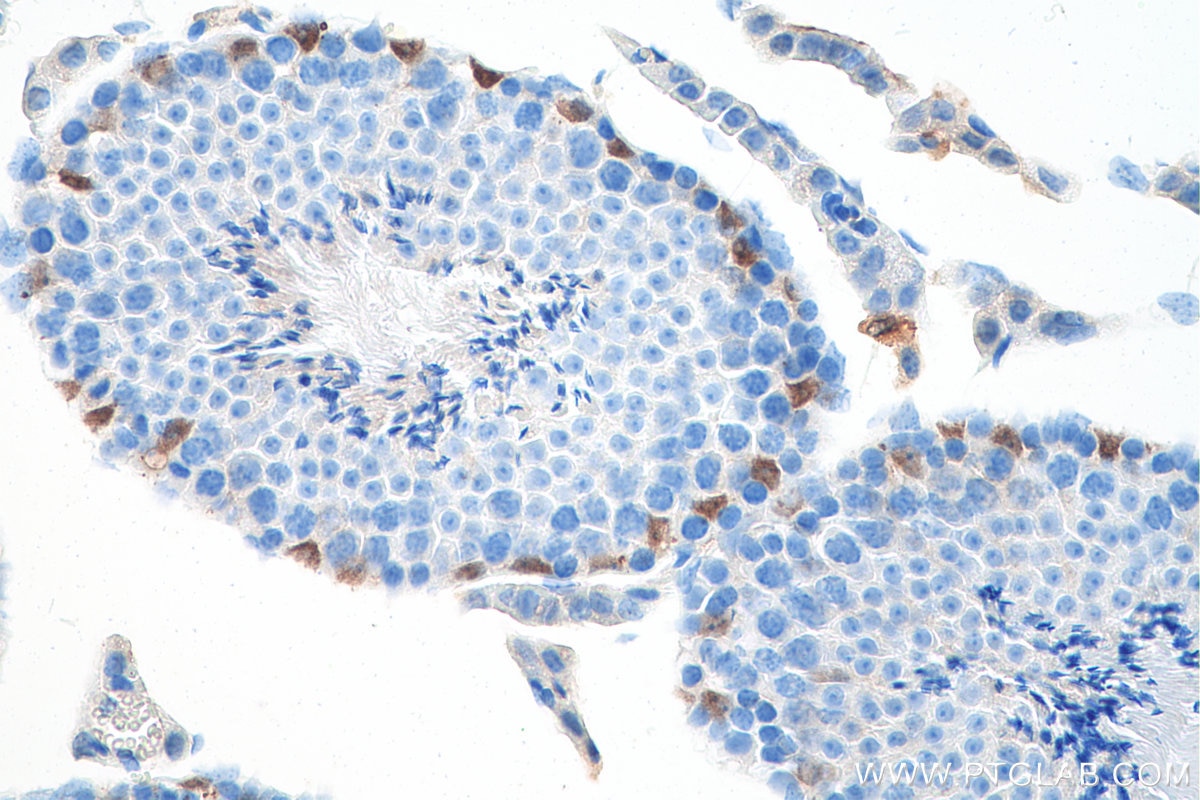Tested Applications
| Positive WB detected in | HL-60 cells, Raji cells, K-562 cells, NIH/3T3 cells |
| Positive IP detected in | K-562 cells |
| Positive IHC detected in | mouse testis tissue Note: suggested antigen retrieval with TE buffer pH 9.0; (*) Alternatively, antigen retrieval may be performed with citrate buffer pH 6.0 |
Recommended dilution
| Application | Dilution |
|---|---|
| Western Blot (WB) | WB : 1:1000-1:6000 |
| Immunoprecipitation (IP) | IP : 0.5-4.0 ug for 1.0-3.0 mg of total protein lysate |
| Immunohistochemistry (IHC) | IHC : 1:50-1:500 |
| It is recommended that this reagent should be titrated in each testing system to obtain optimal results. | |
| Sample-dependent, Check data in validation data gallery. | |
Published Applications
| KD/KO | See 2 publications below |
| WB | See 12 publications below |
| IHC | See 5 publications below |
| IF | See 1 publications below |
| CoIP | See 1 publications below |
| ChIP | See 2 publications below |
Product Information
10917-2-AP targets GATA1 in WB, IHC, IF, IP, CoIP, ChIP, ELISA applications and shows reactivity with human, mouse samples.
| Tested Reactivity | human, mouse |
| Cited Reactivity | human, mouse, zebrafish |
| Host / Isotype | Rabbit / IgG |
| Class | Polyclonal |
| Type | Antibody |
| Immunogen |
CatNo: Ag1350 Product name: Recombinant human GATA1 protein Source: e coli.-derived, PGEX-4T Tag: GST Domain: 1-316 aa of BC009797 Sequence: MEFPGLGSLGTSEPLPQFVDPALVSSTPESGVFFPSGPEGLDAAASSTAPSTATAAAAALAYYRDAEAYRHSPVFQVYPLLNCMEGIPGGSPYAGWAYGKTGLYPASTVCPTREDSPPQAVEDLDGKGSTSFLETLKTERLSPDLLTLGPALPSSLPVPNSAYGGPDFSSTFFSPTGSPLNSAAYSSPKLRGTLPLPPCEARECVNCGATATPLWRRDRTGHYLCNACGLYHKMNGQNRPLIRPKKRLIVSKRAGTQCTNCQTTTTTLWRRNASGDPVCNACGLYYKLHHQHYCGGSAQLMRAQSMASRGGVVSFS Predict reactive species |
| Full Name | GATA binding protein 1 (globin transcription factor 1) |
| Calculated Molecular Weight | 43 kDa |
| Observed Molecular Weight | 50-55 kDa, 40-45 kDa |
| GenBank Accession Number | BC009797 |
| Gene Symbol | GATA1 |
| Gene ID (NCBI) | 2623 |
| RRID | AB_2108279 |
| Conjugate | Unconjugated |
| Form | Liquid |
| Purification Method | Antigen affinity purification |
| UNIPROT ID | P15976 |
| Storage Buffer | PBS with 0.02% sodium azide and 50% glycerol, pH 7.3. |
| Storage Conditions | Store at -20°C. Stable for one year after shipment. Aliquoting is unnecessary for -20oC storage. 20ul sizes contain 0.1% BSA. |
Background Information
GATA1 is first identified as a member of the GATA transcription factor family, whose members bind the consensus (WGATAR) binding motif [PMID:22937757]. GATA1, a zinc finger DNA-binding transcription factor, plays a critical role in the normal development of hematopoietic cell lineages. The protein contains an N-terminal region that confers transcriptional activity and a C-terminal domain that mediates binding to DNA and other factors [PMID: 8524811]. GATA-1 is also implicated in regulating the expression of the erythroid and megakaryocytic-specific genes [PMID:22937757]. GATA1 exists two isoform with the molecular weight 50-55 kDa and 40-45 kDa (PMID: 31189107 ).
Protocols
| Product Specific Protocols | |
|---|---|
| IHC protocol for GATA1 antibody 10917-2-AP | Download protocol |
| IP protocol for GATA1 antibody 10917-2-AP | Download protocol |
| WB protocol for GATA1 antibody 10917-2-AP | Download protocol |
| Standard Protocols | |
|---|---|
| Click here to view our Standard Protocols |
Publications
| Species | Application | Title |
|---|---|---|
Theranostics Differential effect of cancer-associated fibroblast-derived extracellular vesicles on cisplatin resistance in oral squamous cell carcinoma via miR-876-3p
| ||
Oncogene microRNA-23a, -27a and -24 synergistically regulate JAK1/Stat3 cascade and serve as novel therapeutic targets in human acute erythroid leukemia. | ||
iScience Superenhancer-driven circRNA Myst4 involves in pulmonary artery smooth muscle cell ferroptosis in pulmonary hypertension | ||
Front Immunol FLI1 Induces Megakaryopoiesis Gene Expression Through WAS/WIP-Dependent and Independent Mechanisms; Implications for Wiskott-Aldrich Syndrome. | ||
Genes (Basel) Proof of Gene Doping in a Mouse Model with a Human Erythropoietin Gene Transferred Using an Adenoviral Vector. | ||
Oncotarget The transcription factor GATA1 and the histone methyltransferase SET7 interact to promote VEGF-mediated angiogenesis and tumor growth and predict clinical outcome of breast cancer. |














